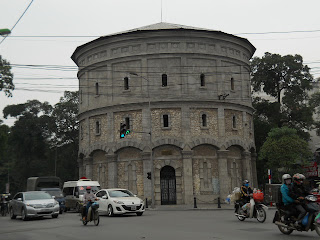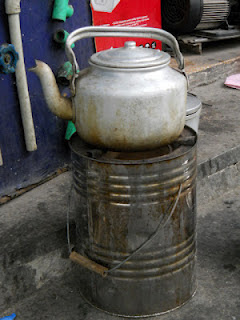 The bustling Hang Khoai Street where Chợ Đồng Xuân market is located offers a real insight of the daily activities of the local people.
The bustling Hang Khoai Street where Chợ Đồng Xuân market is located offers a real insight of the daily activities of the local people.This is also a great place for sampling some of the cheap street food where most of the food stalls were in the small alleys.

Towards the eastern end of Hang Khoai Street-Nguyen Thiep Street traffic junction is a cyclinder shaped building know as Thap Nuoc Hang Dau or Hang Dau Water Tower constructed by the French in 1894.
The water tank's( French:Chateau D'eau) capacity is 1250 cubic metres and has now been redundant.

Next to the water tank building is a small park with a statue of a soldier and a women that looked like the Lady of Liberty.
The wording here says 'Spiritually(Quyet Tu) Sacrifice(Quyet sinh) for the Nation(De To Quoc)'

Busy street barbers attending to customers around the park.
This place is quite cooling with lines of trees providing the canopy.

The end of Hang Khoai Street meets Tran Nhat Duat main highway road and on the left is Long Bien Railway Station.
This stairway entrance is in between some of the shops but further down is another main access road.

A narrow road leading to the railway station with no signboard.
Street stalls lining on both sides.
Family Hostel is inside one of the alley near the railway station in Gam Cau Street.
Room rates is around USD15.
The owner possibly owns another hostel of the same name in Cau Go Street.
Main entrance to Ga Long Bien ticketing counters.
Fast Train Departure schedule from Long Bien Terminal.
To Hai Phong:(leaving/arrival) 09:30/12:10, 15:35/18:00 and 18:10/ 20:35
Hai Phong is a coastal city and has a deep water port.It is the second largest industrial centre of the north.
To Quan Trieu: 14:35/ 17:30
Quan Trieu is in Thai Nguyen Province,near Thai Nguyen capital city which is a first class city and the 9th largest city in Vietnam.
A center of heavy industries in northern Vietnam especially with the presence of TISCO Iron and Steel Company,a susidiary of the TATA Group headquartered in Mumbai,India.
To Yen Bai:13:06 /18:00
A mountainous provincial city in north central Vietnam and is an important transport hub which link to the border town of Lao Cai and into Yunan in China.
Ticket counter operating hours:05:00 till 21:00.
Hanoi - Hai Phong Express Train destinations fares: 1) Cam Giang-30,000VND -a rural district (huyện) of Hai Duong province in the Red River Delta region of Vietnam.
2) Hai Duong-35,000VND -provincial capital and a highly developed industrial zone.
3) Phu Thai-45,000VND -capital city of Kim Thành District,a rural district of Hai Duong province in the Red River Delta region of Vietnam.
4) Hai Phong-55,000VND -20km from Hai Phong is the Gulf of Tonkin and a beautiful beach in a small peninsula is Do Son beach,a tourist resort.
A casino is in Do Son Resort Hotel.
Another company Hoa Phuong with the heading title 'High Quality Car Coach' offering Hanoi-Hai Phong train service.
In the timetable also mentioned leaving Hanoi which must be the main station at Gia Lam.
Leaving Hanoi at 06:00 arrived at 08:15 and 16:05 arrived at 18:05.
Long Bien station:09:30/12:10, 16:06/18:06 and 18:00/20:00
Fares: Cam Giang=25,000/32,000VND
Hai Duong=35,000/40,000VND
Phu Thai=45,000/50,000VND
Hai Phong=55,000/60,000VND

States ticket fares and goods handling charges schedule for northern destinations.
Main operator is Vietnam Railway.
This one is a slow train(viet:gia tau) stopping at many stations along the way.
Judging from the tickets price,they must be the hard seater. Gia Lam=10,000 (Hanoi main station at Le Duan Street.) Lang Son=23,000 (bordering China's Guangxi Province)

Train schedule fares Long Bien right till Dong Dang terminal.
Fares:60,000VND. Dong Dang is about half hour journey(20km) from Lang Son City which is near China's Quanxi Province.
Dong Dang(3km to the border) is the busiest international gateway via the Youyi Guan - Huu Nghi Quan( Friendship Pass).
On the China side,you'll reached the city of Pingxiang before reaching Nanning.

Train routes from Long Bien to Lao Cai.
Fares:180,000VND
Lao Cai and Sa Pa are two important cities within the province at the border with China and is a very popular tourists destination.
Lao Cai is the last stop before crossing into China on way to Kumming(Yunnan Province) across the border, which lies at the end of the train line to China.

Trains routes from Long Bien to Yen Bai(180km from Hanoi). Yen Bai Province borders Lao Cai, Ha Giang in the north, Son La Province in the west, Tuyen Quang in the east, and Phu Tho in the south.
The province has many beautiful sceneries and natural landscape.

Long Bien Rail Track Bridge built in 1903 across Red River that connects the two parts of Hanoi.
It was originally called Paul Doumer Bridge.Paul Doumer was the Governor-General of French Indochina.
The roads on both side were specially for motorcyclists.

It was heavily bombarded during Vietnam War due to its critical position (the only bridge at that time across the Red River and connect Hanoi to the main port Haiphong).
Some parts of the original structure remain intact, while large sections have been built later to repair the holes.
Only half of the bridge retains its original shape. Today trains, mopeds, bicycles and pedestrians use the dilapidated bridge, while all other traffic is diverted to the nearby Chuong Duong Bridge and some newly built bridges: Thanh Tri Bridge, Thang Long Bridge, Vinh Tuy Bridge, and Nhat Tan Bridge.
Under the bridge, around forty extremely poor families live in boats on the Red River, coming from many poor rural areas of Vietnam.
View of part section of the Long Bien Bridge from Tran Nhat Duat Road.
Noticed that there was a wall or dyke separating the main road to the other side of the communities.

This section of the bridge uses the most steel bar in construction and the engineering technology used by French engineers is superb.
The bridge span is 1,682metres. Inside one alley near the road entrance to Long Bien train station were many stalls selling glasswares,teapots,ceramic,kitchen wares and household utensils.

These chinawares teapots looked very nice.

Shopowner carrying huge piles of clothes hangers on his motorbike trying to manouvere along this narrow alley.
Glass jars and containers.
Storing ginseng herbs inside the glass jar.
Baguette seller.

Traditional stove using charcoal is still in commonly being used.









No comments:
Post a Comment